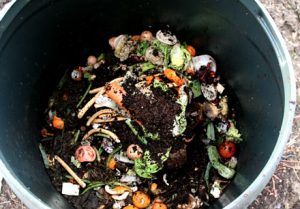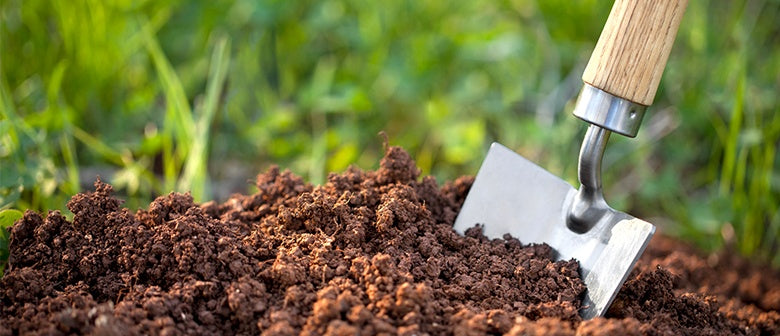Preparing your Soil for Spring
BY: Bec Wenzel
Once the ground starts to warm up your plants will be ready to burst with growth, but if the soil is less than desirable you may not get the results you want.
I love soil, I’m not even kidding. I’m fascinated by the many micro organisms that live in the soil. Just by adding the right amount of TLC to the soil you can create a thriving ecosystem that helps nourish your plants.
I find that the best thing you can do for your soil is add organic matter.
Compost
 Compost is decomposed organic matter so anything from food waste to grass clippings that has been left to decompose in a compost heap. By adding compost to your garden you are improving the soil structure. This helps aerate the soil and helps with water movement throughout the soil. It also adds nutrients and beneficial micro organisms. You also won’t have to water as much and coming into the warmer months this is exactly what you want. You can make your own compost by buying or making a compost bin, but if you are looking for the cheaters way (my way most of the time!) you will find pre-bagged compost in store.
Compost is decomposed organic matter so anything from food waste to grass clippings that has been left to decompose in a compost heap. By adding compost to your garden you are improving the soil structure. This helps aerate the soil and helps with water movement throughout the soil. It also adds nutrients and beneficial micro organisms. You also won’t have to water as much and coming into the warmer months this is exactly what you want. You can make your own compost by buying or making a compost bin, but if you are looking for the cheaters way (my way most of the time!) you will find pre-bagged compost in store.
Compost is the first thing I add to my soil to get it spring ready.
Manure
 Manure is fantastic for the garden, another type of organic matter. It conditions the soil whilst promoting earth worm activity and adding nutrients for your plants. Make sure the manure has been set aside to rot before use as when used fresh it can burn tender plants. There are several types of manure that you can use.
Manure is fantastic for the garden, another type of organic matter. It conditions the soil whilst promoting earth worm activity and adding nutrients for your plants. Make sure the manure has been set aside to rot before use as when used fresh it can burn tender plants. There are several types of manure that you can use.
Sheep pellets: I prefer to use sheep manure most of the time as it comes in pellet form which makes it easy to use. They are compacted with the sheep’s wool. The lanolin helps promote earth worm activity. The pellets work as a slow release fertiliser and add structure to your soil. They can be added deeply to the soil for deep rooted vegetables or scattered on the top few inches for your fast growing crops. If I plant trees and shrubs I like to put a few handfuls of pellets at the bottom of the holes before planting.
Another thing I like to do with sheep pellets, and you could probably try this with other manures as well is I like to add some to a bucket or watering can and then fill with water. This creates a liquid fertiliser in which you can use to water in your new plants or seedlings or to feed the plants when needed. The good thing about this liquid feed is you can keep refilling with water until all the pellets have broken down, so it is extremely good value.
Chicken manure: Chicken manure is extremely high in nitrogen and potassium and is great for leafy greens and flowering plants.
Cow manure: Before using cow manure it should be set aside for a few months. It is not particularly high in nutrients but does an excellent job of adding organic matter to the soil and improving soil structure to soil that are either sandy or clay.
There are numerous other products on the market to add to your soil to get it bursting with energy. Dynamic lifter, blood and bone, and garden lime are other products that will get your soil thriving.
Dynamic lifter is a mix of blood and bone, fishmeal and seaweed so it is a powerhouse of organic matter. It comes in pellet form so releases nutrients slowly into the soil.
Blood and bone will increase the nitrogen levels in the soil for healthy plant growth, it also adds phosphorous for strong root development.
Mulching
Mulch is the very top layer you want to add to your prepared soil. Mulch can be anything that provides a barrier from the air to the soil. Popular mulch choices are bark, stones, pea hay and straw.
The benefits you get from adding a layer of mulch are it can help suppress the weed population in your garden beds. One of the biggest advantages by far is it helps with water retention, so less watering is required. It also helps either keeping root systems cool in summer or warm in winter. If you choose an organic mulch such as the hay or the bark it will also break down and add to the organic matter in your soil over time.
For an ornamental or flower garden you may find something more attractive such as bark mulch or stones is more suited. Bark mulch looks fantastic and adds to the soil as it breaks down.
In my vegetable garden I love to put down lots of pea hay. It really adds to the soil quality as it breaks down quicker, and is very high in nitrogen.
Those three steps alone should get any soil thriving. Compost, manure and mulch. You can’t go wrong.

















